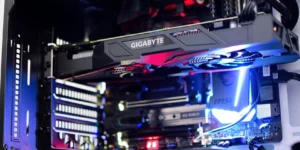Need a complete computer upgrade or just want a Memory, Hard drive or Graphics card upgrade. All components are available and ready for installation.
Investing small amounts in key new PC hardware can keep your computer running strong for years to come. These upgrades—most costing well under $100—breathe new life into slow machines. You just have to be strategic and make sure you’re putting your money in the best place for your particular system. See our rates here.

Computer slow. Need an Upgrade?
An SSD is one of the cheapest and effective computer upgrades you can perform. We will ensure all files and programs are transferred over with minimal hassle.
Possible upgrades
- 1. Upgrade to an SSD (Solid State Drive)
- 2. Add More RAM (Memory)
- 3. Upgrade Your Graphics Card (GPU)
- 4. Install a Secondary Hard Drive or SSD
- 5. Upgrade the Power Supply Unit (PSU)
- 6. Improve Cooling Solutions
- 7. Upgrade Your Monitor
- 8. Upgrade Peripherals (Keyboard, Mouse, etc.)
- 9. Upgrade Your Operating System or Software
- 10. Add a Wi-Fi/Bluetooth Card
1. Upgrade to an SSD (Solid State Drive)
- Why: SSDs are much faster than traditional HDDs, resulting in quicker boot times, faster file transfers, and improved overall system responsiveness.
- How: Clone your existing hard drive to the new SSD, then replace the old drive with the SSD.
2. Add More RAM (Memory)
- Why: Increasing your RAM allows your computer to handle more tasks simultaneously and can improve performance in memory-intensive applications.
- How: Check your motherboard’s RAM compatibility (DDR3, DDR4, etc.), buy compatible RAM sticks, and install them in the available slots.
3. Upgrade Your Graphics Card (GPU)
- Why: A better GPU can vastly improve gaming performance, video editing, and any graphics-intensive applications.
- How: Ensure your power supply can support a more powerful GPU, then install the new card into the PCIe slot on your motherboard. Update drivers afterward.
4. Install a Secondary Hard Drive or SSD
- Why: Additional storage can help organize data and ensure your primary drive isn’t overloaded, which can slow down performance.
- How: Purchase an additional hard drive or SSD, mount it in your case, and connect it to your motherboard via SATA cables.
5. Upgrade the Power Supply Unit (PSU)
- Why: A more reliable or higher wattage PSU ensures your components receive adequate and stable power, especially after adding new hardware.
- How: Choose a PSU with the correct wattage and efficiency rating, then swap it with the old PSU, reconnecting all necessary power cables.
6. Improve Cooling Solutions
- Why: Better cooling can enhance performance and extend the lifespan of your components by preventing overheating.
- How: Install additional case fans, replace the stock CPU cooler with a more efficient one, or consider liquid cooling options for advanced setups.
7. Upgrade Your Monitor
- Why: A higher resolution, larger screen, or higher refresh rate monitor can significantly enhance your viewing and gaming experience.
- How: Simply connect the new monitor to your computer via HDMI, DisplayPort, or other compatible cables.
8. Upgrade Peripherals (Keyboard, Mouse, etc.)
- Why: High-quality peripherals can improve your overall user experience, comfort, and productivity.
- How: Purchase peripherals that suit your needs (e.g., mechanical keyboards, high-DPI mice) and connect them via USB or wireless.
9. Upgrade Your Operating System or Software
- Why: Newer versions often include performance improvements, security updates, and new features.
- How: Follow the upgrade instructions provided by your OS or software provider.
10. Add a Wi-Fi/Bluetooth Card
- Why: Enhance your connectivity options, especially if you’re using an older motherboard without built-in Wi-Fi or Bluetooth.
- How: Install a Wi-Fi/Bluetooth expansion card into a PCIe slot on your motherboard, or use a USB adapter for a simpler solution.
A great resource is this pc part picker utility here.
